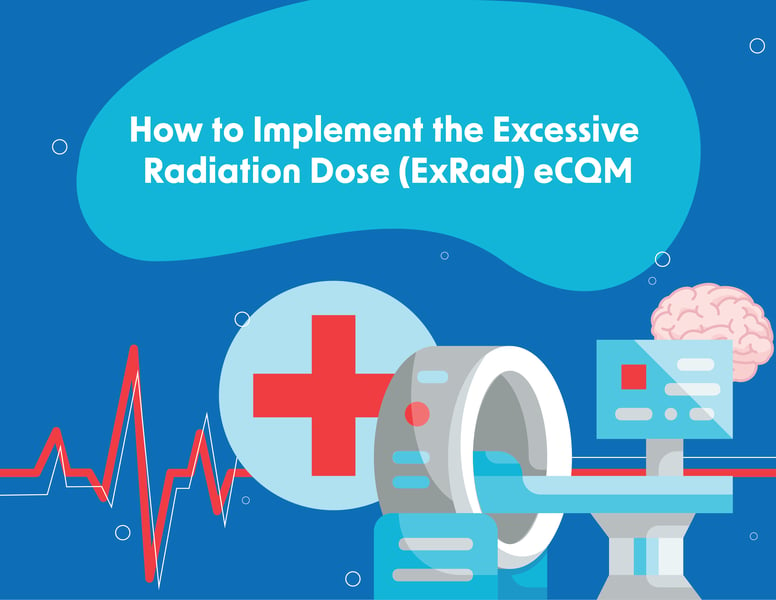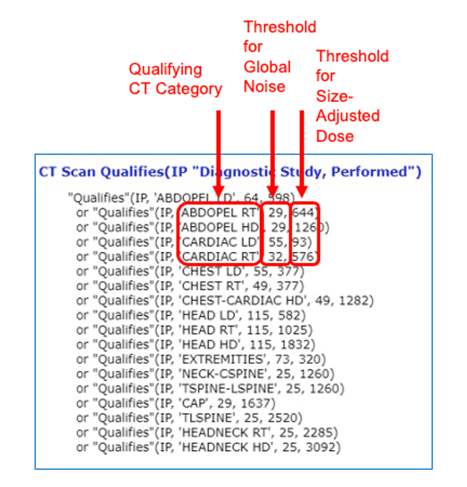How to Implement the Inpatient ExRad eCQM

CMS has added a new eCQM to the Inpatient Quality Reporting (IQR) program for 2025. The measure is known as ExRad: Excessive Radiation Dose or Inadequate Image Quality for Diagnostic Computed Tomography (CT) in Adults (Hospital Level — Inpatient) (IP-ExRad).
The IP-ExRad measure is the first eCQM to require outside software to help translate some data into a usable eCQM format.
While this measure is voluntary for the IQR program, it’s important for your organization to start tracking and improving your performance right away. CMS has finalized versions of this measure for the Quality Payment Program (QPP) and the Outpatient Quality Reporting (OQR) program. Under the OQR program, the measure is mandatory starting in 2027.
Here’s everything you need to know to get started on this new measure.
Why do we need the ExRad eCQM?
Using CT scans has significantly improved the diagnosis and treatment of many conditions, but it also increases patients’ exposure to ionizing radiation, which contributes to the development of cancer. With more than 90 million CT scans performed every year in the U.S., CMS developed this measure to emphasize the importance of radiation dose management.
What does this mean for quality managers? This eCQM is an important patient safety measure to help your organization track the performance of diagnostic CT use. It can help your quality team adhere to guidance for CT use to discourage unnecessarily high radiation doses while also preserving image quality.
What is the ExRad eCQM?
The IP-ExRad eCQM is also known as CMS 1074; you can find the specification here at the eCQI Resource Center. ExRad was finalized in the 2024 IPPS Final Rule, and CMS is making it available to submit in the IQR program starting in 2025. Medisolv clients can begin tracking performance in 2024. We hope this will help you prepare for the similar measure coming to the OQR program, which is required for submission in 2027.
This measure is an inverse measure, so lower rates are better. It will calculate the percentage of CT scans that either used an excessive radiation dose or had an inadequate image quality relative to the threshold.
ExRad eCQM Populations
Let’s review the measure populations to help you understand how a patient is placed in a population.
Initial Patient Population (IPP)
Laymen’s description:
The IP-ExRad eCQM looks at all patients with a qualifying CT scan performed during the reporting period. To be included in the IPP, the patient must be 18 years or older and receive a CT scan during their hospital stay.
Unlike other eCQMs, the patient only needs to have a hospital stay that overlaps the reporting period. The patient does not need to be admitted or discharged during the reporting period; some part of the encounter just has to “cross” the reporting period to be included in the calculation.
If the patient is over 18 and has a CT scan during an inpatient encounter, during the measurement period, the following criteria must also be met. First, the patient’s scan must have a CT dose assigned to the scan, which calculates the patient’s radiation exposure. Next, the scan must include an image quality category, which assesses the quality of the image produced. If any of these components are missing from the scan, the patient’s encounter will not be considered for the eCQM.
Simplified logic:
- Inpatient encounter (overlaps measurement period – includes any patient admitted during the measurement period; includes any patient discharged during the measurement period)
- Age > 18 years
- CT scan with CT Dose and Image Quality Category during inpatient encounter
Denominator
Laymen’s description:
The denominator is the number of encounters (from the IPP) with a diagnostic CT scan performed. To qualify, the CT scan must have an assigned CT category, a size-adjusted radiation dose value, and a global noise value.
Simplified logic:
- Presence of any CT scan category and
- Calculated global noise value (not null) and
- Calculated CT size-adjusted dose value (not null)
What is global noise value?
Image noise is often defined as the grainy appearance that may occur on a scan that makes it difficult for the radiologist to read. Put simply, it refers to image quality. Poor image quality may not only hinder diagnosis but also require the patient to receive an additional scan, further exposing the patient to radiation.
Denominator Exclusions:
Laymen’s description:
If the CT scan was for the full body.
Simplified logic:
- CT scan with result = full-body
Numerator
Laymen’s description:
The numerator is a patient encounter that qualifies for the denominator population, is not excluded, and has either a noise or a dose above the listed thresholds, according to the scan category (see table below). Values for the noise and dose thresholds are identified by the numbers to the right of each scan category (noise, dose). These values are used to determine if the patient falls into the numerator population.
Simplified logic:
- Result (from “CT Scan Qualifies” table)
- Calculated CT size-adjusted dose value > value per “CT Scan Qualifies” table
or - Calculated CT global noise value > value per “CT Scan Qualifies” table

Mapping the ExRad eCQM
- IPP: To capture that a CT was performed, the scan must be mapped to Diagnostic Study, Performed: CT dose and image quality category (LOINC 96914-7).
- Denominator, exclusions, and numerator:
- To capture the scan result, mapping must include the description code (e.g. ABDOPEL LD, CHEST RT, etc.)
- Global noise values must be mapped to LOINC 96912-1, and the size-adjusted dose values must be mapped to LOINC 96913-9.
Implementing the ExRad eCQM will require significant mapping. While most eCQMs require mapping one code to one data element, ExRad requires four codes per data element. It requires the text result code, the result noise code, the result size-adjusted dose code, and the code for the diagnostic study.
The ExRad is the first eCQM to require a separate translation software to convert data from your Picture Archiving and Communication System (PACS) and Radiology Information System (RIS) into an eCQM-readable format. This eCQM uses string texts to identify the procedure, rather than the codes typically used in eCQM reporting. The translation software will enable access to primary data elements stored within radiology data systems and translate them into a usable format for eCQMs.
This software will be available for free from one vendor: Alara Imaging Services. Alara has released some details on the software and implementation requirements, which can be found here, as well as a list of frequently asked questions to help organizations plan for the software implementation. It’s clear the implementation will require additional steps for your eCQM team.
We’ll be sure to update you as new information on this software becomes available.
Helpful Tips for the ExRad eCQM
- Get started now with the inpatient ExRad eCQM so your organization will be ready for mandatory outpatient ExRad reporting by the time it’s required.
- Meet with the eCQM stakeholder team to review the specifications.
- Determine who else needs to be involved to oversee the software implementation and data management and reporting.
- Contact your EHR and Alara Imaging for additional information and install the software when it becomes available.
Questions? We’re here to help. Reach out to Medisolv today so we can help you support your team. We’ll keep you informed of new developments, along with guidance on how to set up the measure, and quality improvement strategies.
Medisolv Can HelpAlong with award-winning software, each client receives a dedicated Clinical Quality Advisor that helps you with your technical and clinical needs. We consistently hear from our clients that the biggest differentiator between Medisolv and other vendors is the level of one-of-one support. Especially if you use an EHR vendor right now, you’ll notice a huge difference.
|





Comments